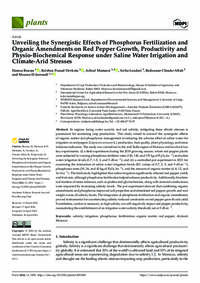Unveiling the Synergistic Effects of Phosphorus Fertilization and Organic Amendments on Red Pepper Growth, Productivity and Physio-Biochemical Response under SalineWater Irrigation and Climate-Arid Stresses

Authors:
In regions facing water scarcity and soil salinity, mitigating these abiotic stresses is paramount for sustaining crop production. This study aimed to unravel the synergistic effects of organic matter and phosphorus management in reducing the adverse effect of saline water for irrigation on red pepper (Capsicum annuum L.) production, fruit quality, plant physiology, and stress tolerance indicators. The study was carried out in the arid Tadla region of Morocco and involved two key experiments: (i) a field experiment during the 2019 growing season, where red pepper plants were subjected to varying phosphorus fertilizer rates (120, 140, and 170 kg of P2O5.ha−1) and saline water irrigation levels (0.7; 1.5; 3; and 5 dS.m−1); and (ii) a controlled pot experiment in 2021 for examining the interaction of saline water irrigation levels (EC values of 0.7, 2, 5, and 9 dS.m−1), phosphorus rates (30, 36, and 42 kg of P2O5.ha−1), and the amount of organic matter (4, 8, 12, and 16 t.ha−1). The field study highlighted that saline irrigation significantly affected red pepper yields and fruit size, although phosphorus fertilization helped enhance productivity. Additionally, biochemical markers of stress tolerance, such as proline and glycine betaine, along with stomatal conductance, were impacted by increasing salinity levels. The pot experiment showed that combining organic amendments and phosphorus improved soil properties and stimulated red pepper growth and root weight across all salinity levels. The integration of phosphorus fertilization and organic amendments proved instrumental for counteracting salinity-induced constraints on red pepper growth and yield. Nonetheless, caution is necessary as high salinity can still negatively impact red pepper productivity, necessitating the establishment of an irrigation water salinity threshold, set at 5 dS.m−1.
